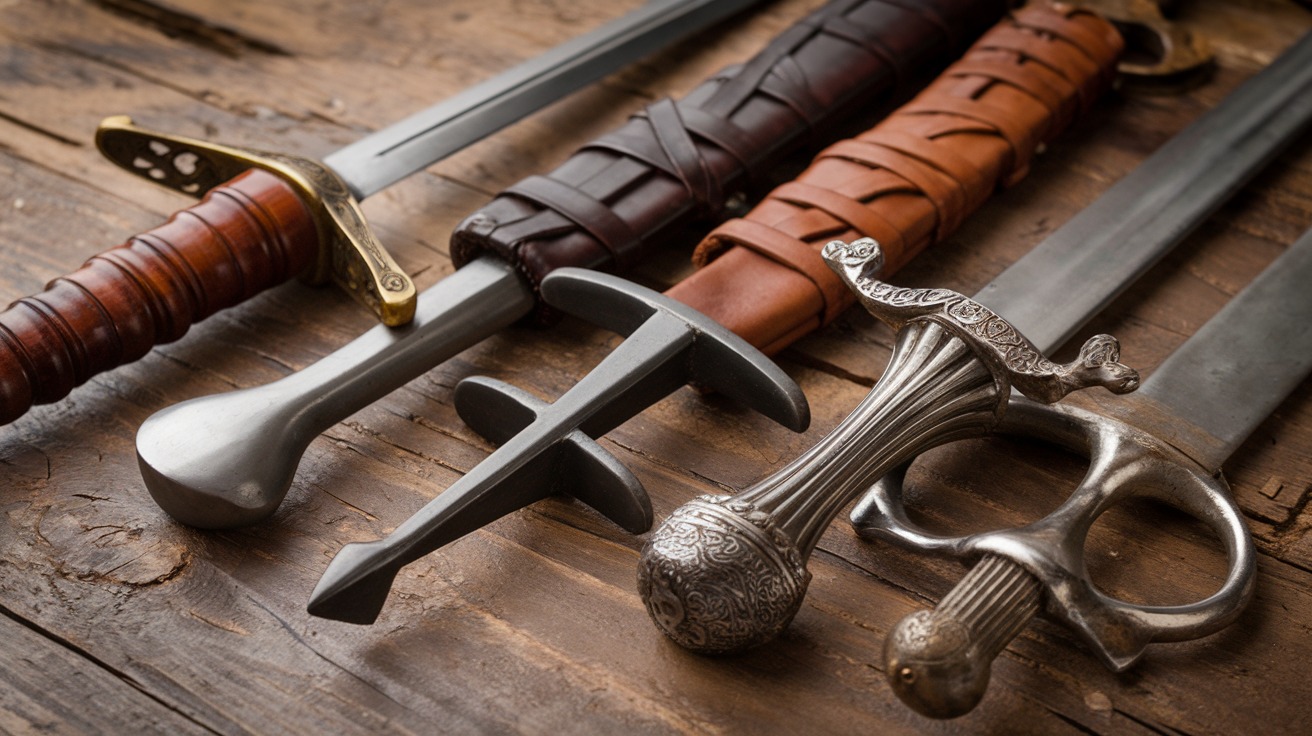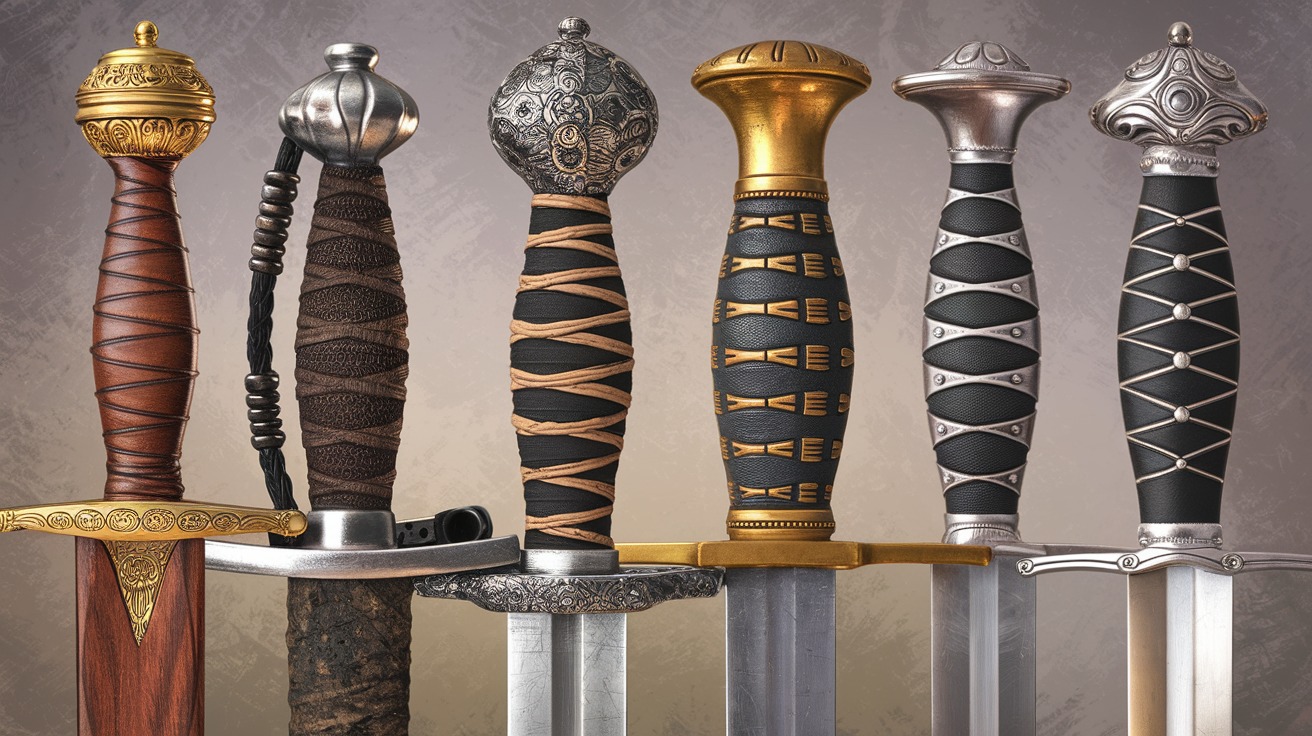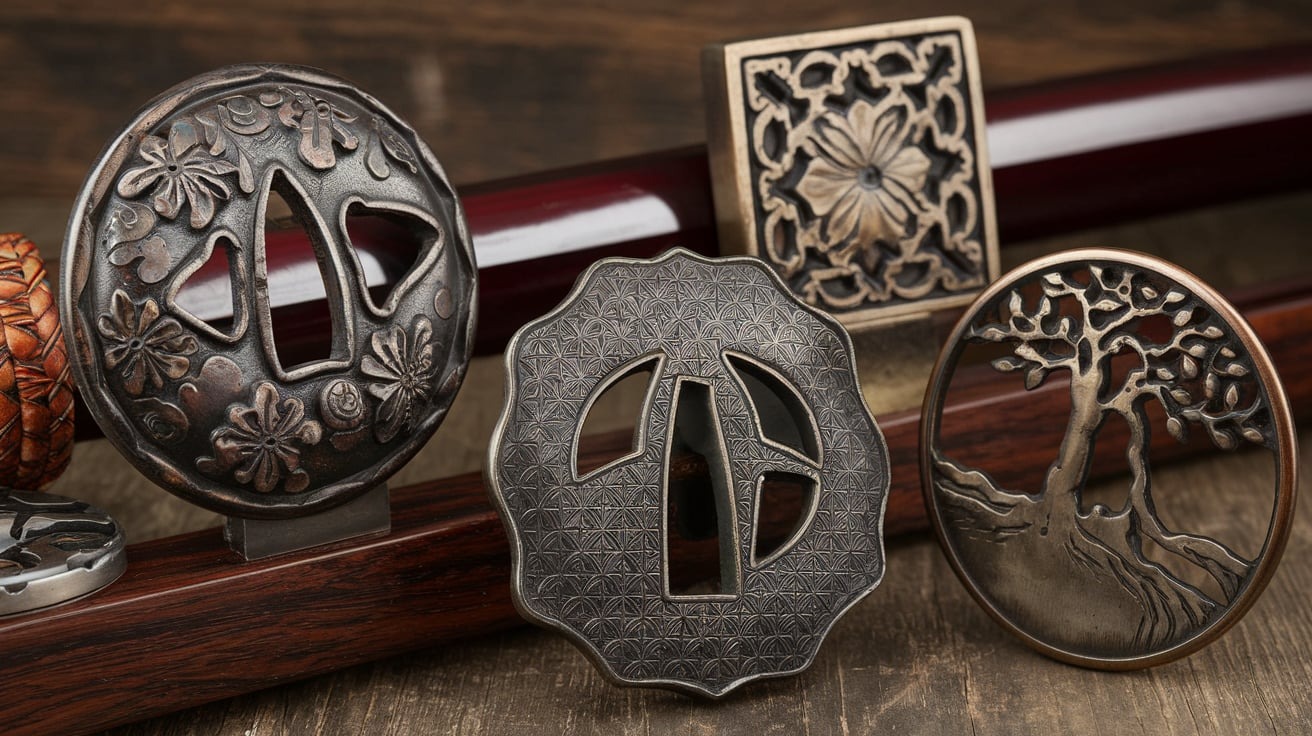Blog
Types of Sword Hilts and Guards: Balancing Function and Design

A sword hilt is the handle of the sword and is a very important part of the sword for 2 reasons; it is the part which the warrior holds while fighting with a sword and secondly, the sword hilt is the protectable portion of the sword which protects the warrior’s hand. Taking into consideration many sword hilt types and guards helps the understanding of the philosophy of the sword construction and design of the ages. This article examines different Hilts and Guards features, functional components, and design styles that integrate aesthetics and purpose.
What is the Hilt of a Sword?
The hilt refers to the entire handle of a sword, which includes several important components: the grip, the guard, and the pommel. Together, these elements enhance the sword’s usability and safety in combat. The design of each part of the hilt influences the weapon’s balance, control, and defensive capabilities.
What is a sword guard?
The sword guard is a metal element connecting a blade with its handle. It keeps the fighter safe, protects the hand from slipping onto the sharp blade, blocks attacks from an opponent, and adds to the sword’s style. A sword comes with multiple guard variations depending on its design. For example, Japanese swords have a tsuba, while European swords have a crossguard. Some sword guards are simple, while others have beautiful designs and decorations. They are helpful for fighting and are important in history and art.
What materials are used to make sword hilts and guards?
Sword hilts and guards have different materials over time. Traditional materials included wood, bone, leather, and metals like iron and bronze, which gave them strength and a good grip. Some hilts were wrapped in fabric or wire for comfort. Modern innovations use stainless steel, alloys, and even carbon fiber, making swords lighter, stronger, and more durable.
How Hilts Influence a Sword’s Function, Design, and Combat Style?
The hilt of a sword influences its function, design, and combat style. It provides grip, balance, and protection, allowing better handling and control. Different designs, like the katana’s tsuba or the longsword’s crossguard, reflect cultural styles. The hilt’s size and shape affect combat style, enabling swift thrusts, powerful swings, or defensive techniques depending on its structure and purpose.
Sword hilts have evolved over centuries, adapting to different fighting styles, materials, and cultural influences. Early swords had simple hilts, but as combat techniques advanced, hilts became more complex to improve grip, balance, and hand protection. Here are different sword hilts according to different era.
1. Ancient Sword Hilts
Like those from ancient Mesopotamia and Egypt, the oldest swords had simple wood or metal handles. They did not have much hand protection, as they were mainly used for slashing attacks. These early swords were elemental in design but practical in battle.
2. Medieval Hilts
Greek and Roman swords, like the gladius, had short, straight handles, making them perfect for quick stabbing in close fights. In medieval times, European swords added cross guards to protect the hand from enemy attacks. Viking swords had rounded pommels and straight guards, which helped balance the Viking sword and made it useful for different fighting styles.
3. Renaissance Era Hilts
During the Renaissance, swords like the rapier had fancy hilts with cup or basket-shaped guards to protect the hand during fights. In Asia, Japanese katanas’ hilts had a tsuba (guard) and wrapped handles, making them easy to control with two hands. In the Middle East, scimitars had curved guards, helping warriors make fast, smooth slashing attacks.
4. Modern Hilts Adaptations
In the 18th and 19th centuries, military swords like sabers had fancy, curved guards that protected the hand and looked stylish. Today, sword hilts are mainly used for ceremonies or collections, often made with beautiful designs and high-quality materials, instead of for battle.
What are the Different Components of a Sword Hilt?
1. Grip
The portion held by the wielder, typically made of wood, metal, or leather. The grip may be wrapped in leather, wire, or cloth to ensure a better hold.
2. Guard
The section between the blade and the grip protects the wielder’s hand from sliding onto the blade or being struck by an opponent’s weapon.
3. Pommel
The pommel is rounded or flat heavy knob at the end of a sword hilt. It helps balance the sword, making it easier to swing and control. In battle, it can be used as a striking weapon. Pommels also secure the grip, preventing the blade from coming loose. Over time, they became decorative, showing different styles and symbols.
What are the Different Sword Hilt Types?
Different sword hilt types were developed to meet the needs of various combat styles across regions and periods. Here are some of the most iconic hilt designs:
1. Longsword Hilt
The longsword hilt is long enough to accommodate two hands, providing leverage for powerful strikes. It typically features a cruciform guard extending outward in a straight line perpendicular to the blade, offering effective hand protection. The pommel is often rounded or disc-shaped for balance.
2. Katana Hilt
Swordsmiths traditionally wrap the katana hilt, or tsuka, in materials like silk or cotton to ensure a secure grip. They typically design the guard (tsuba) in a circular or square shape, focusing more on symbolism and decoration, though it still provides some protection. The pommel (kashira) balances the weapon and complements the sword’s aesthetic.
3. Rapier Hilt
The rapier features one of the most intricate hilt designs. The long, thin blade pairs with a hilt with a complex guard of loops and rings, protecting the hand during thrusting attacks. Some rappers have a swept hilt, where bars extend around the hand in an elegant, swirling pattern, while others may feature a cup-shaped guard (cup hilt) to shield the wielder’s hand fully.
4. Viking Sword Hilt
Viking sword hilts are typically simple yet functional. They have short grips, often just long enough for one hand, and a simple crossguard. The large pommel, often lobed or disc-shaped, helps counterbalance the short, wide blade.
Sword Guard Types and Designs
The guard is one of the most critical aspects of the sword hilt, and its development advances as combat needs evolve. Here are some of the other noteworthy examples:
1. Crossguard
One of the earliest and most easily identifiable sword mounts, the crossguard, commonly balances medieval European swords, such as the longsword. This simple straight bar runs across the blade and prevents the user’s hand from slipping forward toward the blade and strikes from the enemies toward the hand.
2. Basket Hilt
People often refer to the basket hilt as a “basket-handed sword” due to the sword’s broad blade. The basket hilt forms a cage around the hand to give it more growth. This method of enabling maximum protection is especially effective for slashes, jabs, or even thrusts in close-quarter combat.
3. Knuckle Bow
The knuckle bow is a kind of guard that goes from the crossguard to wrap around the hand onto the pin, providing further hand protection. You can see this type of guard on construction tools like small swords and cutlasses.
4. Ring Guard
The ring guard consists of rings mounted and attached at two points along the sword at the guard’s base, on both sides of the blade. It allows some hand protection but does allow for much quicker sword-hunting, so it is favored in the rapier and other thrusting weapons.
5. Leather Wrapped Handles
For a secure and comfortable grip, many swords feature leather-wrapped handles. These grips prevent slippage and add a traditional look to the sword.
Functional Variations of Sword Hilts
Sword hilts vary by size, shape, and purpose. One-handed hilts offer speed, two-handed give power, straight ones aid thrusting, curved ones improve slashing, and decorative ones enhance beauty.
1. One-Handed vs. Two-Handed Hilts
One-handed hilts allow faster, precise strikes, often seen in rapiers and arming swords. Two-handed hilts, like those on katanas and claymores, provide great power and control.
2. Straight vs. Curved Sword Hilts
Straight hilts offer better thrusting ability, which is common in longswords and rapiers. Curved hilts improve slashing motion, often found in sabers and scimitars for swift, fluid attacks.
3. Fuller Hilts and Decorative Variants
Fuller hilts enhance grip and reduce weight, improving balance and usability. Decorative hilts, used in ceremonial swords, feature intricate designs and premium materials for decoration and reputation.
What is the functionality of sword hilts?
Sword hilts provide protection, balance, and control. They help guard the hand, distribute weight for easier handling, and ensure a firm grip for precise movements.
1. Protection for the Hand
The hilt includes a guard that shields the hand from enemy strikes, preventing injury during combat. Some swords have curved or basket-shaped guards for extra protection.
2. Balance and Weight Distribution
The pommel at the end of the hilt helps balance the sword, making it easier to swing and control without feeling too heavy.
3. Enhancing Grip and Control
The handle is designed for a strong grip, often wrapped in leather, fabric, or wire. This helps the user hold the sword firmly and use it with precision.
Can Modern Sword Hilts Replicate Historical Designs Accurately?
Modern sword hilts can accurately copy historical designs. Skilled makers use traditional materials like wood, leather, metal, and modern tools to recreate authentic details. Some swords are made for display, while others are fully functional. Modern hilts can match the look and feel of ancient swords, whether for collectors, reenactors, or martial artists.
How to Choose the Right Sword Hilt?
Choose a sword hilt based on use, material, balance, and history to ensure comfort, control, durability, and authenticity for combat or display. Swords Kingdom offers swords with well-crafted hilts, ensuring quality and historical accuracy.
- Intended Use: Choose a hilt based on purpose, combat needs, and durability. Display favors aesthetics, and reenactment requires historical accuracy while ensuring comfort and safety.
- Material Preference: Hilts come in wood, leather, or metal. Wood offers a traditional feel, leather improves grip, and metal provides durability, each suited for different needs.
- Weight and Balance: A well-balanced hilt ensures better control. A heavy hilt adds stability, while a lighter one allows faster movements, depending on the fighting or display style.
- Historical Accuracy: For collectors and reenactors, hilts should match the sword’s era and culture. Accurate designs enhance authenticity, making the sword a true reflection of history.
How do you maintain sword hilts?
To maintain a sword hilt, regularly clean it with a dry or slightly damp cloth to remove dust. Metal parts should be oiled to avoid rust, while leather grips need conditioning to prevent cracking. Wooden hilts benefit from polishing with wood oil. Check for loose parts and tighten them if needed. Always store the sword in a dry place to prevent damage.
Conclusion
The sword hilt and guards type testify to the marriage of function and form. From the elegant complexity of rapier hilts to the robust simplicity of Viking swords, each design aims to protect the wielder and enhance their control over the weapon. Understanding these elements helps appreciate the skill and artistry of sword-making across centuries. Whether you are a collector, martial artist, or enthusiast, the diverse world of sword hilt designs offers endless fascination.


